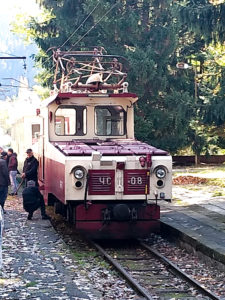“The water that takes care of you”.

See photos
Where is Borjomi?
The town of Borjomi is one of the districts in the Samtskhe-Javakheti region, situated in the northwestern of the region in the picturesque Borjomi Gorge on the eastern edge of the Borjomi-Kharagauli National Park in south-central Georgia.
Getting there
Our journey from Mestia to Borjomi was in marshrutkas.
Our accommodation
During our time in Borjomi, we chose to stay at Hotel Victoria. Booked through Booking.com.
A centrally located hotel, with clean, spacious rooms.
Immediately next door to the Hotel Victoria is My House Restaurant. A lovely cafe/restaurant serving very nice snacks and meals.
A few doors down the street is the Old Borjomi Restaurant. A good restaurant, serving traditional Georgian cuisine.
Places of interest
We dropped off the backpacks at our accommodation and went exploring. Initially going down the steps opposite our hotel into Merab Kostava’s Garden. Leaving the Garden and walking down Baratashvili Street, adjacent to the Borjomula River towards Borjomi Central Park.
Blue Palace “Firuza”
Just outside the entrance of the Central Park is the Blue Palace “Firuza”. Built in 1892 by the consul of Iran it is considered a cultural monument of Borjomi. The building is a combination of Persian, Georgian and European architecture. As the name suggests, it is blue in colour.

Borjomi Central Park
Entrance to the Central Park is 2 GEL per person. Going into Borjomi Central Park, you are entering the home and source of the famous Borjomi mineral spring water. The Borjomi springs were discovered by the Imperial Russian military in the 1820s. They were made famous throughout the Russian Empire. Making Borjomi a popular tourist destination. The history of the brand is closely associated with the Russian imperial dynasty of the Romanovs.
The water is free. However, a lady seats at the entrance selling plastic cups. Tania tried the waters, said it was warm, and had a salty taste.
With all the water surrounding you. You might need to take a quick toilet break.

Strolling through the park is pleasant. Amusements and cafes line the walk. Continuing through the park reveals a high waterfall and the Monument of Prometheus. Depicting the mythical figure standing on a stone slab wearing a gold loincloth. The figure is holding a flaming golden globe in his hands. Referring to Prometheus stealing fire from the Gods and giving it to mortals.

Walking a further 2.5 km takes you on to the thermal pools. At 5 GEL per person entrance fee. The pools are reported to be beneficial for the skin and other ailments. The small semicircular shaped pool is the warmest. Being the closest one to the spring. The larger rectangular pool is deeper. There are cafes, changing rooms, and showers at the complex, together with free Wifi. As it was getting dark we didn’t make it to the pools.

Borjomi Cable Car
At the entrance to Central Park, there is a cable car that goes up to the Borjomi Plateau. A plateau with a Ferris wheel and further hotels. It provides a great view of the town, Central Park. valley gorge and mountains. The charge for the cable car is 5 GEL per person.
Kukushka Railway “little cuckoo”
We took the 2.5 hr journey on the Kukushka railway (Russian for “little cuckoo”). It is a 37.2 km narrow gauge railway line. Linking the town of Borjomi to the village and ski resort of Bakuriani, which is 1,700m above sea level. Construction of this 900 mm line began in 1897, whilst Georgia was still part of the Russian Empire, taking four years because of the difficult terrain.

The first train ran in January 1902. The Romanovs commissioned Gustave Eiffel to design the viaduct over the Tsemistskhali River. Still, standing it looked a bit rickety, thankfully it didn’t collapse.

The cost was 2 Gel per person for a one-way ticket. There are 2 trains a day from Borjomi. The first at 0715 hrs and the second at 1055 hrs. Each train gives you about an hour in the town of Bakuriani, before its return. We took the 1055 hrs train. Arriving in Bakuriani at 1315 hrs. Having walked into the town from the train station.

We had a drink and something to eat. We didn’t have time to return to the station for the 1415 hrs return. Instead, taking a marshrutka back to Borjomi. A journey time of 30 mins at a cost of 3 Gel per person.

Khachapuri is a traditional Georgian dish of cheese-filled bread. The bread is leavened and allowed to rise and is shaped in various ways. Usually with cheese in the middle and a crust that is ripped off and used to dip in the cheese. The filling contains cheese, eggs, and other ingredients.
Tip 🚆
This train does not leave from Borjomi Parki Train Station, which is adjacent to Merab Kostava’s Garden. It leaves from Borjomi Railway Station which is a 5-minute marshrutka ride or 30-minute walk from the town.
Borjomi Kharagauli National Park
Covering approximately 8% of Georgia. The Borjomi Kharagauli National Park is the largest in the country. At present, there are eight tourist hiking trails operating in the park. Varying in length, duration, and complexity. Open from April until October.
Go to the Park administration office to get a free hiking permit and a map of the area. The map indicates the routes and shelters on the 1, 2, or 3-day trails through the forests and meadows.


